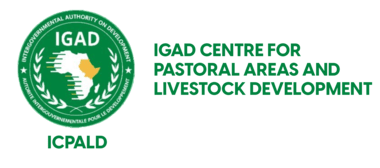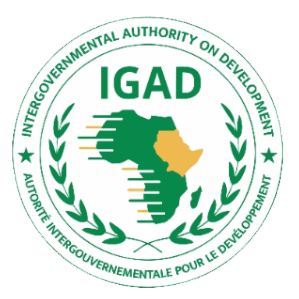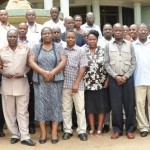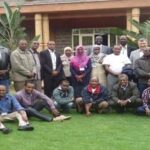A workshop for creating a community-based disease reporting system for Uganda was held in Kampala, from 23rd to 24th July 2015. Its main aim was to seek for stakeholder input into developing and improving community-based grassroot disease reporting system in Uganda as means to improve passive surveillance and disease reporting. In addition, the workshops helped to strengthen grassroot disease recognition through further circulation of syndromic manuals. The workshop brought together a total of 60 stakeholders involved in the livestock sector, including, Livestock farmers, Community Animal Health Workers, Livestock traders, Field Veterinarians, Regional Veterinary Inspectors Private veterinary practitioners, Veterinary Drug shop owners, and Representatives from the National Drug Authority (NDA), Uganda Wildlife Authority (UWA), Regional Veterinary Laboratories, Makerere University College of Veterinary Medicine, Animal Resources and Biosecurity (COVAB), Officials of the Ministry of Agriculture Animal Industry and Fisheries (MAAIF), FAO, NGOs and AU-IBAR. As well, Luwero, Ngora, Koboko, Sheema, Mukono, Masaka, Mpigi, and Nakaseke districts were represented.
In her welcome remarks, Dr. Nantima Noelina the Principal Veterinary Epidemiologist Ministry of Agriculture Animal industry and Fisheries thanked AU- IBAR and SMP-AH project in particular for the development of the SMPs and syndromic manuals to aid disease surveillance, identification and reporting in the IGAD countries and for organizing the the workshop for disseminating the syndromic manuals. She informed participants that Uganda is an agricultural country but livestock diseases are a challenge. She requested workshop participants to receive and put to use the syndromic manuals provided in order to help in disease surveillance, diagnosis and prompt reporting in Uganda.
In his remarks, Dr Joseph Magona, on behalf of the Director, AU-IBAR, Prof. Ahmed Elsawalhy, pointed out the substantial contribution livestock resource makes towards the national economies in the IGAD region, food security and livelihoods of communities. He informed members that the IGAD region has a huge livestock resource estimated to be over 438 million ruminants. He further noted that despite the huge livestock resource, trans-boundary animal diseases (TADs) continue to affect livestock production and trade in the region. He pointed out that the workshop for creating the community-based grassroot disease reporting system was intended to strengthen grassroot disease recognition through utilization of the syndromic manual by livestock stakeholder, and streamline the chain of disease reporting from the grassroot livestock stakeholders to the ARIS Database Managers in the Epidemiology unit at the national level. Finally, he encouraged all livestock stakeholders in Uganda to embrace the usage of the syndromic manuals and promptly report diseases to responsible officers.
In his official opening remarks, Dr. Wesonga Wanderema, Commissioner for Animal Health, Ministry of Agriculture Animal Industry and Fisheries, on behalf of the Director Animal health, emphasized the need for continuous passive and active surveillance, diagnosis of diseases, and recording data on the disease situation in Uganda. The presence of this information would help in decision-making and implementation of quick action. He reminded participants that disease reporting as a matter of policy is mandatory. He recognized the involvement of all stakeholders along the livestock value chain, hence the syndromic manuals disseminated and the disease reporting system designed would be very vital in disease surveillance, epidemiological investigations and disease reporting of livestock diseases that affect trade in livestock and livestock products. He thanked the SMP-AH project for development of the syndromic manuals and other documents like SMPs on trans-boundary diseases such as FMD, LSD, CBPP, RVF and other diseases to aid disease surveillance and reporting.
The workshop achieved the following:
- A design for community-based grass root disease reporting system in Uganda discussed ;
- Stakeholder input into the community-based grassroot disease reporting system sought;
- Awareness to grassroot livestock stakeholders on the syndromic manual created;
- Networking between livestock keeping communities, animal health service providers and other stakeholders at district and county levels enhanced.
Proceedings
The workshop was conducted through presentations, plenary discussion, and group work. Experts from AU-IBAR and MAAIF facilitated the training.
SMP-AH overview and strengthening passive disease surveillance and disease reporting
The presentation highlighted the project overview and elaborated challenges affecting livestock in the region that the project addresses. It concluded by stressing the need to strengthen passive surveillance of TADs through appropriate disease recognition followed by enhanced disease reporting. These two vital aspects would be achieved through usage of the syndromic manual and a strong community-based grassroot disease reporting system.
Creation of a community based reporting system
Initially, all 60 participants were given copies of the syndromic manual to help improve their knowledge on disease recognition. The participants were then divided into four groups and tasked to create a community-based grassroot disease reporting system. The tasked included the following:
- Identifying grass root players in disease reporting
- Identifying the existing structures and channels for disease reporting including the chain of disease reporting
- Identifying means of transmitting disease reports from grassroot stakeholder across the reporting chain
- Identifying persons at each node of the reporting chain responsible for receiving, consolidating disease reports and facilitating onward transmission of the reports to the higher level for disease response and action
- Establishing easy and user friendly formats for disease reporting and feedback disease response actions
- Establishing frequency of transmission of disease reports along the reporting chain
- Establishing the frequency of feedback and disease response actions from higher revels to grass root stakeholders
- Linking the reporting chain to and maintain a functional information database at the centre (i.e. ARIS II)
- Identifying necessary workshops to bring together grassroot stakeholders and responsible persons at each level of the reporting chain including the database manager to operationalize the disease reporting system
- Identifying means to train and motivate responsible persons and equip the system to sustain the disease reporting system.
- Identifying required financing and possible resource mobilization to strengthen various aspect of the disease reporting chain
Key Discussions
Groupwork generated useful discussions and suggestions. Roles of stakeholders in the disease reporting system were identified. Regarding livestock farmers, they were vital in disease reporting in the villages. It was suggested to have a volunteer village animal disease reporter equipped with a smart phone for easy and quick reporting. Village animal health volunteers would be trained in disease reporting and provided with means of transport for quick and easy movement to the areas to get disease reports. Village animal reporters would be provides with facilitation, and incentive as a motivation.
Local political leaders would be involved in creating awareness about livestock diseases within the communities especially during disease outbreaks and disease control campaigns. For traders, their role would be to provide quick disease publicity, especially to do with trade animals in livestock markets and slaughterhouses. Community animal health workers (CAHW) would receive direct reporting from farmers. In-turn they would transmit reports to field veterinarians. For Area Veterinarians, their main roles were conducting disease investigation and diagnosis, report diseases to the District Veterinary Officers (DVO), and were responsible for inter-sectoral reporting e.g. UWA reporting to MAAIF and vice versa. District Veterinary Officers would (1) supervise disease reporting, (2) send reports to MAAIF, (3) send feedback to the communities, (4) facilitate the CAHWs to collect information, (5) organize district trainings for the lower cadres, (6) undertake regular technical backstopping to lower cadres, and (7) Disseminate syndromic manuals to the stakeholders at lower levels. For officials at the MAAIF headquarters, their main roles include, (1) receiving reports from districts including Makerere university and Uganda Wildlife Authority and Research Institutions, (2) undertake data entry in the ARIS database, analyze and interpret data, (3) Write reports and give feedback, and (4) take action.
Key challenges to reporting, included, (1) Limited compelling force from MAAIF to districts to ensure timely submission of reports, (2) Inadequate staffing in districts, and (3) Concealment by district staff to report for fear of quarantine.
Recommendations
Following lengthy deliberations, the participants made the following recommendation:
To Government of Uganda and AU-IBAR
- To provide computers, modems, smart phones, data (airtime) for the ARIS program and train more staff in ARIS II to enhance capacity for disease database management
- To hold a national review meeting and districts level review meetings to improve the reporting system
- To provide support to the community-based grassroot disease reporting system establishment in Uganda through capacity building and dissemination of awareness information.
- To supply more copies of syndromic manuals to all stakeholders for easy disease identification and reporting.
- To organize exposure tours for stakeholders to other Member States to exchange knowledge and learn from disease reporting and animal health management elsewhere in region
- Equip and train players involved in disease reporting and provide relevant equipment e.g. motorcycles, vehicles and bicycles.
To GoU
- To nominate village disease reporters from farmer groups and cooperatives equipped, trained, facilitated and motivated for easy and quick disease reporting
- To recruit more Veterinary Officers to enhance grassroot disease reporting and technically facilitate grassroot disease reporting stakeholders
- To design a simple disease reporting form to be used at farm level
- To develop a mechanism for provision of feedback on disease status to the communities
- SMP-AH focal point person to specify the roles of every stakeholder in the disease reporting chain
- SMP-AH focal person and the Director-Animal Resources to ensure institutionalization of the implementation of community based disease reporting system in the country.
- The head of Epidemiology unit to compel districts to regularly submit reports
- The Commissioner Animal Health to strengthen enforcement in cases of disease outbreaks
- To hold a sensitization workshop for LCV, CAO, RDC and other policy makers on disease reporting and disease control
Way forward
- The SMP-AH focal person in collaboration with AU-IBAR to organize a national workshop involving all relevant institutions to operationalize the a community-based grassroot disease reporting system in Uganda by September 2015
- The SMP-AH focal person in collaboration with MAAIF and AU-IBAR to organize zonal awareness creation workshops by November 2015
- The SMP-AH focal person in collaboration with MAAIF, Local Governments and AU-IBAR to organize quarterly district supervision workshops to strengthen community–based grassroot disease reporting at village level starting from December 2015
Done this 24th July 2015






